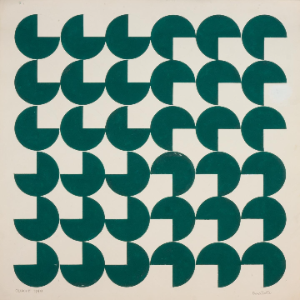Activity 1
Figure 1 – Study by Luiz Sacilotto featuring the repetition of geometric shapes in gouache.

Question 1
In this study by Luiz Sacilotto, we can observe the repetition of certain geometric shapes as well as the presence of geometric transformations. Which geometric shapes do you identify in this study?
Question 2
Which geometric transformations do you identify in this study?
- First, create sectors 2, 3, and 4 based on the sector already placed on the screen.
- Then, by applying translations, complete the reinterpretation of the artwork.
Using GeoGebraScript in the Reinterpretation of Sacilotto's Study
Steps to Create the Activity
- Initially, a circular sector was created with center at point C and endpoints at points D and E, using the command:
Sector(Center, Point, Point). - Once the first circular sector was created and named c, the remaining sectors were obtained through translation and rotation. To achieve this, directional vectors were created to indicate the required translations: u and v, where u represents the horizontal direction, v represents the vertical direction, both vectors have a magnitude equal to the diameter of the circular sector.
- For the Setor 2 button to translate the first sector after a 90° rotation about its center, the following command was inserted in the Scripting tab of the button:
d=Translate(Rotate(c,-90°,C),3v). - For the Setor 3 button, the following command was inserted:
e=Translate(Rotate(c,-180°, C),3v + 3u). - For the Setor 4 button, the following command was inserted: f
=Translate(Rotate(c,-270°,C),3u).
Question 3
Explain what the command d=Translate(Rotate(c,-90°,C),3v)
does.
Question 4
Explain what the command e=Translate(Rotate(c,-180°,C),3v+3u)
does.
Question 5
Explain what the command f=Translate(Rotate(c,-270°,C),3u)
does.
Step 2 – Translations of Circular Sectors.
- After creating the four circular sectors, translations were applied to these sectors to complete the reinterpretation. To achieve this, four additional buttons were created.
- In the Translation Sector 1 button, in the Scripting tab, the following commands were inserted:
c_1=Translate(c,u)
c_2=Translate(c,2u)c_3=Translate(c,v)c_4=Translate(c,2v)c_5=Translate(c,u + v)c_6=Translate(c,2u + 2v)c_7=Translate(c,u + 2v)c_8=Translate(c,2u + v)Question 6
Explain each command inserted in the Translation Sector 1 button.
Question 7
What should the commands be for the Translation Sector 2 button?
Question 8
What should the commands be for the Translation Sector 3 button?
Question 9
What should the commands be for the Translation Sector 4 button?
Question 10
Justify why an error occurs in the execution of the programming when clicking any of the translation buttons before clicking the buttons to create sectors 2, 3, or 4.